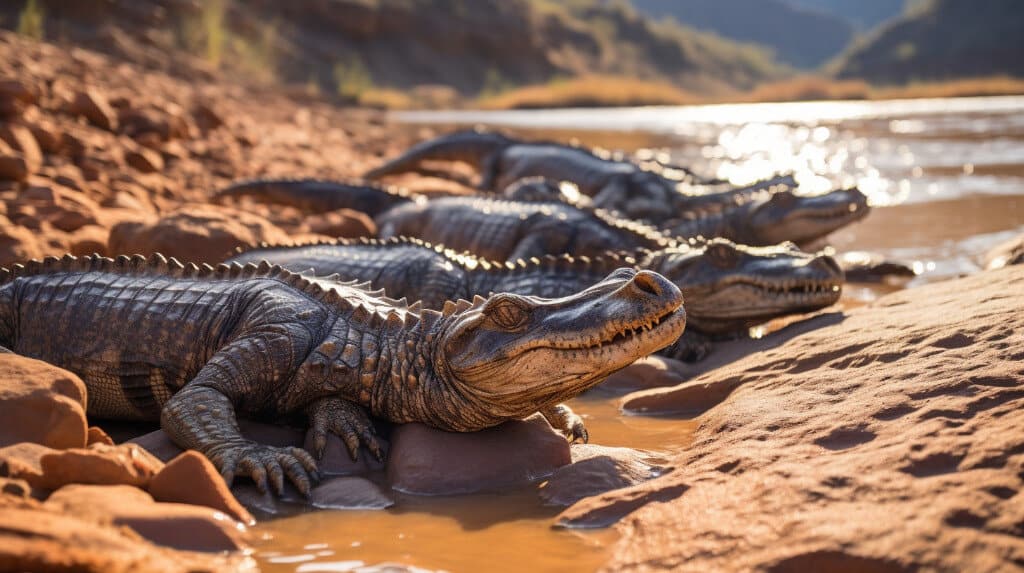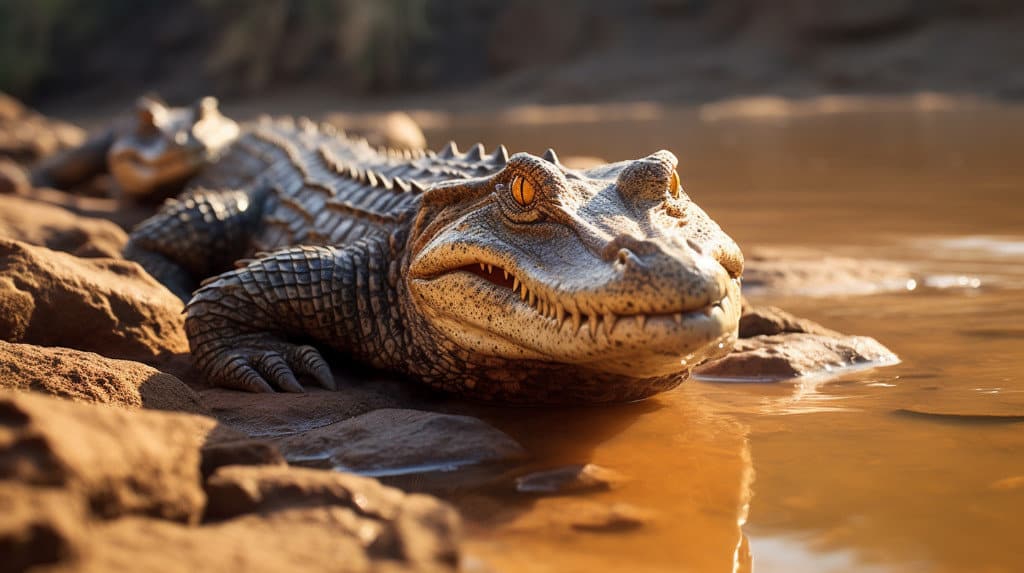The color of a crocodile can vary depending on its species and habitat. Generally, crocodiles have a dark green or brown color that helps them blend in with their surroundings, such as the murky waters or muddy banks of rivers and swamps. This natural camouflage allows them to remain hidden from their prey and potential predators. However, some crocodile species, like the Nile crocodile, can also have a lighter shade of green or gray. It’s important to note that the color of a crocodile can change slightly depending on factors such as age, diet, and exposure to sunlight.
Key Takeaways
| Crocodile Species | Color |
|---|---|
| Nile Crocodile | Green or Gray |
| Saltwater Crocodile | Dark Green or Brown |
| American Crocodile | Dark Green or Brown |
| Morelet’s Crocodile | Dark Green or Brown |
| Cuban Crocodile | Dark Green or Brown |
Understanding the Basic Color of Crocodiles

Crocodiles are fascinating creatures known for their unique coloration and appearance. The color of a crocodile’s skin can vary depending on the species and its habitat. Let’s explore the different colors of some popular crocodile species and understand how their coloration helps them survive in their environments.
Color of a Saltwater Crocodile
The Saltwater Crocodile, also known as the Estuarine Crocodile, is the largest living reptile and is found in the brackish and freshwater habitats of Southeast Asia and Australia. These crocodiles have a dark greenish-brown color on their back, which helps them blend in with the surrounding vegetation. The belly is usually lighter in color, ranging from white to yellow. This color variation allows them to camouflage themselves while hunting or lying in wait for their prey.
Color of a Siamese Crocodile
The Siamese Crocodile is a critically endangered species found in Southeast Asia. These crocodiles have a unique coloration, with a dark olive-green or brownish color on their back and sides. The belly is usually lighter, ranging from yellowish to cream. This color combination helps them blend in with the murky waters and vegetation of their habitat, making it easier for them to ambush their prey.
Color of a Nile Crocodile
The Nile Crocodile is one of the largest crocodile species and is found in various parts of Africa. These crocodiles have a dark brown or grayish color on their back, which helps them camouflage in the muddy waters and riverbanks where they reside. The belly is usually lighter in color, ranging from yellowish to cream. This coloration allows them to remain hidden while waiting for their prey to approach the water‘s edge.
Color of a Marsh Crocodile
The Marsh Crocodile, also known as the Mugger Crocodile, is found in the freshwater habitats of the Indian subcontinent. These crocodiles have a light to dark brown color on their back, which helps them blend in with the muddy banks and vegetation of their habitat. The belly is usually lighter, ranging from yellowish to cream. This coloration provides them with effective camouflage, allowing them to surprise their prey while remaining hidden in the water.
Crocodiles have evolved their coloration over time to adapt to their specific habitats and enhance their survival. The variations in color help them blend in with their surroundings, making it easier for them to hunt, avoid predators, and protect their territories. The combination of scales, pigmentation, and behavior plays a crucial role in their overall appearance and ability to thrive in their environments.
Understanding the basic color of crocodiles provides valuable insights into their biology, behavior, and adaptations. It is fascinating to observe how these reptiles have developed such intricate color patterns to survive in their respective ecosystems. Whether it’s the greenish-brown hues of the Saltwater Crocodile or the dark olive-green shades of the Siamese Crocodile, each species showcases its unique coloration, making them a remarkable part of the wildlife world.
For more information on the coloration of crocodiles, including complete RGB and HEX codes, you can visit the Crocodile Color Information page. There, you can find a detailed breakdown of the color codes primarily used to represent crocodile colors, such as green, brown, yellow, and orange. You can also download images and backgrounds related to crocodile coloration.
Remember, the color of a crocodile is not just about aesthetics; it is a crucial aspect of their survival and adaptation to their environment. So, next time you spot a crocodile, take a moment to appreciate the incredible color variation that nature has bestowed upon these magnificent creatures.
The Variations in Crocodile Colors

Crocodiles are fascinating creatures known for their unique coloration and appearance. These reptiles exhibit a wide range of colors, which can vary depending on the species, habitat, and individual characteristics. Let’s explore the different colors of crocodiles and whether they have the ability to change their color.
Different Colors of Crocodiles
Crocodile species display a diverse array of colors, ranging from earthy tones to vibrant hues. The most common color seen in crocodiles is a dark green shade, which helps them blend in with their natural surroundings. This green coloration is particularly prominent in species like the Nile crocodile, American crocodile, and saltwater crocodile.
However, crocodile coloration is not limited to just green. Some species, such as the Siamese crocodile, have a lighter shade of green or even a yellowish color. Others, like the spectacled caiman, feature a dark brown or black coloration with distinct patterns or markings on their skin.
It’s important to note that crocodile coloration can also vary within a species. Factors such as age, gender, and individual genetics can influence the specific shades and patterns seen in crocodile skin. This natural variation adds to the beauty and uniqueness of these incredible reptiles.
Do Crocodiles Change Color?
While crocodiles do not have the ability to change their color as dramatically as some other animals, they can exhibit slight variations in their appearance. These changes are primarily influenced by environmental factors, such as temperature and lighting conditions.
For example, crocodiles may appear darker or lighter depending on the temperature of their surroundings. Warmer temperatures tend to make their skin appear darker, while cooler temperatures can result in a lighter coloration. This color change is primarily a result of the expansion or contraction of pigments in their skin cells.
Crocodiles also utilize their coloration for camouflage and hunting purposes. The patterns and shades on their skin help them blend into their habitat, making it easier to ambush prey or hide from potential predators. Their scales, which are made of keratin, also contribute to their overall appearance and provide additional protection.
In conclusion, the variations in crocodile colors are a fascinating aspect of their biology and behavior. From the different shades of green to the occasional yellow or brown hues, crocodiles exhibit a diverse range of colors that are both functional and visually striking. By adapting their coloration to their environment, these remarkable reptiles have perfected the art of camouflage and survival in the wild.
For more information on crocodile colors, you can refer to the complete crocodile color code page, which provides detailed information on the RGB and HEX codes for different crocodile colors. You can also download images of various crocodile species to get a closer look at their warm and captivating coloration.
Note: The information provided here is primarily focused on the color variation in crocodiles and does not cover the complete range of crocodile biology, behavior, or characteristics.
Delving Deeper into Crocodile Colors

Crocodiles are fascinating creatures that inhabit various regions around the world. One aspect that captures our curiosity is their coloration. Let’s explore the different colors found in crocodiles and delve deeper into their unique characteristics.
What Color is Crocodile Skin?
Crocodile skin can vary in color depending on the species and their habitat. The most common color seen in crocodile skin is a shade of green. This green coloration helps them blend in with their surroundings, such as the lush vegetation found in their natural habitats. However, it’s important to note that not all crocodiles have green skin. Some species, like the Nile crocodile, have a more brownish coloration, while others, like the American crocodile, have a lighter shade of gray.
What Color are Crocodile Eyes?
Crocodile eyes are known for their striking appearance. They have a unique color that is often described as a mixture of yellow and orange. This warm color adds to their overall intimidating presence. The vibrant hue of their eyes is not only visually captivating but also serves a purpose. It allows them to see clearly both during the day and at night, aiding in their hunting and survival.
What Color are Crocodile Eggs?
Crocodile eggs come in a range of colors, depending on the species. The most common color for crocodile eggs is a creamy white. This color helps camouflage the eggs, making them less visible to potential predators. However, it’s important to note that not all crocodile eggs are white. Some species, like the saltwater crocodile, have eggs with a slightly pinkish hue. This color variation in crocodile eggs is intriguing and adds to the diversity within the crocodile family.
In conclusion, crocodiles exhibit a fascinating array of colors in their skin, eyes, and eggs. Their coloration is not only aesthetically pleasing but also serves important purposes such as camouflage and adaptation to their environment. By understanding the color variation in crocodiles, we gain valuable insights into their biology, behavior, and characteristics.
Unusual Aspects of Crocodile Colors
Crocodiles are fascinating creatures known for their unique coloration. While most people are familiar with their greenish-brown skin, there are several other aspects of their colors that are quite unusual. Let’s explore some of these intriguing characteristics.
What Color is a Crocodile’s Tongue?
Have you ever wondered what color a crocodile’s tongue is? Well, it’s not something you see every day! Unlike humans, crocodiles don’t have a pink tongue. In fact, their tongues are a pale shade of blue-gray. This unexpected color adds to the mystique of these ancient reptiles.
What Color is Crocodile Blood?
Crocodile blood is another aspect of their colors that may surprise you. While human blood is typically red, crocodile blood has a different hue. It is more of a dark green color due to the presence of a pigment called biliverdin. This unique coloration helps crocodiles blend in with their natural habitat and provides them with certain advantages in their environment.
What Color is Crocodile Meat?
Now, let’s talk about the color of crocodile meat. When cooked, crocodile meat has a white to off-white appearance, similar to other types of poultry. However, the raw meat itself can vary in color. Depending on the species and the individual, crocodile meat can range from a light pinkish hue to a slightly darker shade of pink. It’s interesting to see the variation in color even within the same species.
What Color is Crocodile Poop?
Lastly, let’s delve into the color of crocodile poop. While it may not be the most pleasant topic, it’s worth exploring. Crocodile poop, also known as scat, can vary in color depending on their diet. Since crocodiles are carnivorous, their scat is primarily composed of undigested bones, scales, and other animal remains. As a result, their poop tends to be a mixture of dark brown and white, reflecting the colors of their prey.
In conclusion, the unusual aspects of crocodile colors add to the intrigue and wonder of these magnificent creatures. From their blue-gray tongues to their dark green blood, crocodiles possess a unique color palette that sets them apart from other reptiles. Whether it’s the color of their meat or the appearance of their scat, every aspect of their coloration tells a story about their biology, behavior, and adaptations to their environment.
How Crocodiles Perceive Colors
Crocodiles, like many other reptiles, have the ability to perceive colors. While their color vision may not be as advanced as that of humans, it plays a crucial role in their survival and behavior. Understanding how crocodiles perceive colors can provide valuable insights into their biology and adaptations.
What Colors do Crocodiles See?
Crocodiles have a specialized visual system that allows them to perceive colors to some extent. While they may not see the full range of colors that humans can, they are still able to distinguish between certain hues. Research suggests that crocodiles primarily see colors in the green and yellow spectrum, with a limited ability to perceive shades of red and orange.
To better understand how crocodiles perceive colors, let’s take a closer look at their visual system and the factors that influence their color perception:
Reptile Coloration: Crocodiles’ color vision is closely tied to their own skin pigmentation. The color of their scales and skin can affect how they perceive colors in their environment.
Crocodile Habitat: Different crocodile species inhabit various environments, ranging from freshwater rivers to saltwater estuaries. The coloration of their surroundings can impact how they perceive colors. For example, a green crocodile living in a lush, vegetated habitat may have a different color perception compared to a crocodile living in a sandy or rocky environment.
Crocodile Adaptations: Crocodiles have evolved various adaptations to enhance their survival, including their coloration. The ability to perceive colors helps them with camouflage, allowing them to blend into their surroundings and remain hidden from potential prey or predators.
Crocodile Behavior: Crocodiles’ color perception also influences their behavior. For instance, during courtship displays, males may display vibrant colors to attract females. Additionally, color cues from other crocodiles can convey important information about dominance and territorial boundaries.
It’s important to note that color perception in crocodiles may vary among different species. For example, the Nile crocodile, American crocodile, and saltwater crocodile may have slight variations in their color perception due to differences in their habitats and biology.
To get a better idea of how crocodiles perceive colors, researchers have used various methods, including studying the structure of their eyes and conducting behavioral experiments. These studies have provided valuable insights into the visual capabilities of these fascinating reptiles.
In conclusion, while crocodiles may not see the full spectrum of colors that humans do, their ability to perceive certain hues plays a crucial role in their survival and behavior. Understanding how crocodiles perceive colors helps us appreciate their unique biology and the adaptations that have allowed them to thrive in diverse environments.
Conclusion
In conclusion, the color of a crocodile can vary depending on its species and habitat. While most crocodiles have a dark green or brown coloration, some species like the albino crocodile have a white or pale yellow appearance. The color of a crocodile is an adaptation that helps it blend into its surroundings, making it easier to hunt or hide from predators. It’s fascinating to see how nature has equipped these incredible creatures with different colors to survive in their respective environments. So, the next time you spot a crocodile, take a moment to appreciate its unique coloration!
Frequently Asked Questions
What color is a crocodile?
Crocodiles come in a variety of colors depending on their species and habitat. Typically, they are dark green or grey to blend in with their surroundings. Some species, like the American crocodile, may have a lighter, more olive color.
What color is crocodile blood?
Like most vertebrates, crocodile blood is red. This is because it contains hemoglobin, a protein that carries oxygen and gives blood its red color.
Do crocodiles change color?
Yes, some species of crocodiles can change their color slightly to regulate their body temperature or enhance their camouflage. However, this change is not as dramatic or rapid as in animals like chameleons.
What color are crocodile eyes?
Crocodile eyes are generally a shade of yellow or gold. They have a special layer of cells in their eyes called the tapetum lucidum that helps them see in low light conditions, which may give their eyes a reflective property.
What color is a saltwater crocodile?
Saltwater crocodiles, also known as “salties”, are usually a very dark green or almost black color. This helps them blend into their murky aquatic habitats.
What color is crocodile meat?
Crocodile meat is usually a light pink or white color when cooked, similar to chicken. The meat from the tail is considered the most desirable.
What color are crocodile eggs?
Crocodile eggs are usually white or cream-colored. They are laid in clutches and the mother crocodile will often guard them until they hatch.
What color is a crocodile’s tongue?
A crocodile’s tongue is generally a pale pink or white color. It is attached to the bottom of their mouth, so it doesn’t move freely like ours.
What color is a Nile crocodile?
Nile crocodiles are generally a dark olive green color, with a lighter underside. This coloration helps them blend into their riverine habitats.
What color is crocodile skin?
Crocodile skin is typically a greenish, brown, or grey color, depending on the species and its habitat. The skin is covered in hard, bony scales that provide protection and aid in camouflage.




